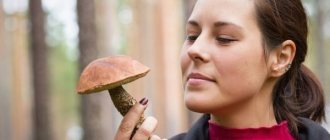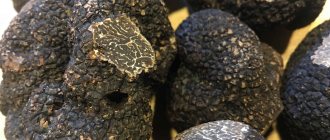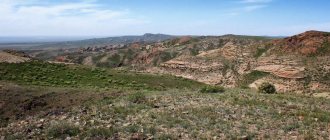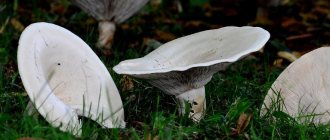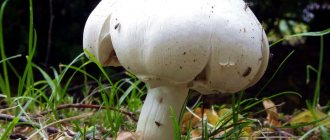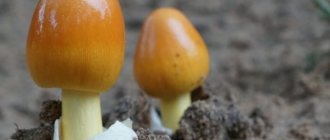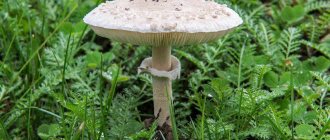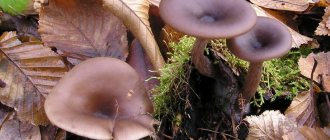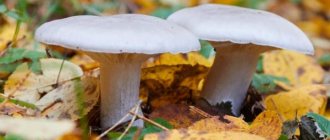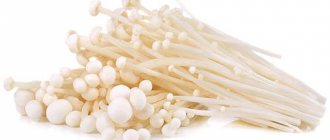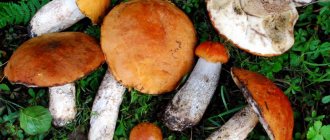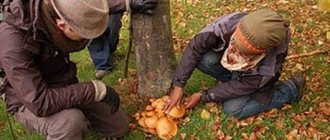- White mushroom - description and photo, characteristics and properties
The porcini mushroom is perhaps the most famous representative of the mushroom kingdom, which could easily be called, without exaggeration, “the king among mushrooms.” Such fame came to him thanks to his extraordinary taste properties and appearance. The white mushroom itself (its Latin name Boletus edulis) belongs to the Boletaceae family, a species of boletus, due to which it is often also called boletus.
White mushroom - description and photo, characteristics and properties
White mushroom cap
The porcini mushroom, as well as other mushrooms of the boletus genus, are famous for their aroma and piquant taste. The cap of the porcini mushroom is brownish-brown in color; it usually grows to 7-30 centimeters in diameter. Although in some especially favorable places you can find a porcini mushroom with a cap 50 cm in diameter.
Good to know: you can determine the age of a porcini mushroom by looking at its cap. So the cap of a young mushroom has an almost artistic convex shape. But older mushrooms have a flatter cap. Also, the older the mushroom, the darker the color of the cap, and its surface itself becomes more rough.
Also, the cap of the porcini mushroom is pleasant to the touch; its upper skin is tightly bound to the pulp of the mushroom and for this reason it is difficult for it to separate from it. In dry or windy weather, the mushroom cap may become covered with deep wrinkles and cracks, causing damage to the internal pores of the mushroom. IN
In the rain, a thin film of mucus forms on the cap of the porcini mushroom.
White mushroom pulp
In a ripe porcini mushroom, it is usually juicy, dense, fleshy and, of course, white. But in old mushrooms it may turn a little yellow.
White mushroom leg
Typically, the height of the stem of an average porcini mushroom is 12 cm, but sometimes in the forest you can find real “giant porcini mushrooms” with a stem height of 25 cm. The shape of the stem of a porcini mushroom is barrel-shaped or club-shaped, but in old mushrooms it can be cylindrical, the diameter of the stem usually about 7 cm. The color of the leg can be from white to brown
How to find boletus
The health benefits of boletus mushrooms have been time-tested. They contain vitamins A, B1, B2, C and D, which are responsible for immunity, skin, hair and nails. Porcini mushrooms are also rich in proteins and have a beneficial effect on the heart.
Mushrooms are recommended to be eaten. We’ll tell you further how to secure a fresh “catch” yourself.
Where does the boletus mushroom grow?
Mushrooms of the genus Boletaceae are common in the temperate climate zone of the globe. They can be found in deciduous and coniferous forests, in particular under oaks, beeches, chestnuts, hornbeams, pines, and spruces.
Boletus likes to grow on sandy soil and loams; more humid conditions (swamps, lowlands) are not so favorable for it. Boletus mushrooms often grow in groups, but they can easily get along alone. There are high chances of finding boletus in these locations:
- from the edge of forest paths, clearings and clearings;
- near lichens and sphagnum mosses;
- in well-sunny places.
The pine forest is the habitat of boletus mushrooms: Unsplash
In dense thickets there is not enough light for them, so you should not wander deep into the forest. Look for mushrooms on the outskirts, but avoid roadways with heavy traffic. Mushrooms tend to absorb harmful substances and will not be so beneficial.
In order for the “quiet hunt” to be successful, Anna Zorina recommends being patient and carefully preparing for mushroom picking. Before going into the forest, carefully study specialized literature, read about edible and inedible types of boletus mushrooms. The following boletus twins are considered poisonous:
- gall (gorchak) has a light brown cap and a gray stalk covered with a thick mesh;
- the beautiful-legged boletus also has a light cap, but is distinguished by a red leg with a lemon tint on top;
- the satanic mushroom has a whitish-gray cap and a stalk with a red mesh;
- speckled oakweed is characterized by a chestnut-brown cap and a yellow-red leg;
- The legal boletus (Boletus le Gal) is distinguished by its pink color with a red mesh on the leg.
Beautiful-legged boletus: Wikipedia/Walter J. Pilsak
When do boletus mushrooms appear?
The porcini mushroom season begins in the warmest time of the year, in July, and lasts until August–September. If conditions are favorable, the first mushrooms may appear as early as early June or even in May. Head to the forest after warm thunderstorms or fogs. This climate provides ideal moisture to the top layer of soil, which boletus mushrooms like. The speed of their growth during these periods becomes phenomenally fast, and all mushroom pickers want to catch a rich harvest.
In warm autumn, porcini mushrooms can grow until the end of October, but with the first night frosts they disappear from the forests.
What to do when a boletus is found? Do not pull it out by the roots, but carefully cut it at the base with a knife so that new boletus mushrooms will appear here next year. If the mushroom is not of sufficient quality, do not throw it away or trample it. Place it on a branch or branch so that local inhabitants can feast on it. After this, carefully search the area nearby: if there is one mushroom, most likely there are more growing nearby.
Hunting for boletus will not only provide a delicious, nutritious dinner, but will also be amazing entertainment. Use these tips to find them and experience the fresh mushroom flavor.
Original article: https://www.nur.kz/family/school/1820261-borovik-opisanie-vidy-gde-rastet/
Types of porcini mushrooms, names and photos
In fact, there are several varieties of porcini mushrooms, and below we will write in detail about them.
White mushroom reticulate
It is also a reticulated boletus, the Latin name is “Boletus reticulatus”, and in appearance it is very reminiscent of a moss fly. Its cap (6-30 cm in diameter) has a brown or ocher color. The leg is cylindrical. The pulp is white. The reticulated porcini mushroom can be found in beech, oak or chestnut forests of Europe, America, and Africa. This mushroom ripens earlier than other porcini mushrooms - in June-September, again depending on the habitat.
White mushroom dark bronze
It is also known as bronze boletus, also known as copper or hornbeam boletus. It differs from other porcini mushrooms in the dark, even brown color of the cap and stem; sometimes similar mushrooms are even found completely black. The leg is also cylindrical. But the flesh of this mushroom is white in color and also has a very pleasant taste. The dark bronze porcini mushroom is particularly common in North America, but can also be found in Europe, especially in oak and beech forests.
White birch mushroom
Its other name is spikelet. A distinctive feature of this mushroom is its light color. The cap, reaching a diameter of 5-15 cm, is almost white in color; sometimes it comes in cream or light yellow colors. The stalk of the spikelet is barrel-shaped, the flesh is white. The birch mushroom grows exclusively under birch trees (hence the name) and is found throughout the habitat of porcini mushrooms, wherever there are birch trees.
White pine mushroom
Also known as boletus mushroom or boletus pine. It is distinguished by a large dark-colored cap, which sometimes has a purple tint. The flesh of this mushroom has a brownish-red color. The stem of this mushroom is short but thick and has a brown or white color. You probably guessed by the name that this mushroom grows under pine trees and is found everywhere in the pine forests of Europe, America, and Asia.
White oak mushroom
The cap of the oak mushroom is brown, but with a gray tint. The flesh of this mushroom is looser than that of other types of porcini mushrooms. Lives in Caucasian oak forests.
Spruce porcini mushroom
The most common among porcini mushrooms. His hat is brown and reddish in color. The leg is long, but with a thickening at the bottom. It usually grows in pine and spruce forests in Europe.
Where do they grow?
Porcini mushrooms grow in different places: found in the forests of Russia, Mexico and the African tropics.
The development cycle directly depends on weather conditions. In temperate climates, the fruiting bodies ripen in late May-early June. Autumn is considered the mushroom season, because until the end of November you can harvest a generous and tasty harvest.
According to the description, they live in colonies, i.e. Several dozen specimens appear on one piece of land. Particularly active during the season of good rain.
Habitats of porcini mushrooms: they grow under pine, birch, oak, in open and sunny clearings or meadows. Loves soil overgrown with moss.
If you are going on a “quiet hunt” for the first time, contact experienced mushroom pickers who will tell you where you can harvest.
Porcini mushroom - benefits, properties, vitamins, minerals
Porcini mushroom has a high mineral content, making it one of the healthiest mushrooms, so what are the benefits of porcini mushrooms?
Also, porcini mushroom has a low calorie content, it can be dried, fried, stewed and pickled for the winter. The taste of the porcini mushroom is simply excellent, although it itself is quite difficult to digest.
Good to know: of all the types of preparation of porcini mushrooms, it is mushrooms in dried form that are best absorbed by humans; with the consumption of dried mushrooms, up to 80% of porcini mushroom proteins enter the body. It is not without reason that nutritionists advise eating dried porcini mushrooms.
Mode of application
BZHU - 35 kcal per 100 g. The calorie content of porcini mushrooms depends on the method of preparation. It is prepared fried, boiled, stewed and dried, and pickled for the winter. In medicine, infusions and decoctions based on mushroom broth are used.
In cooking
Porcini mushrooms have a pleasant taste, which is why they are highly valued in cooking. Their usefulness is due to the unique fats and carbohydrates in their composition - they are necessary to maintain normal well-being.
Only fresh ones are suitable for cooking; if stored raw for some time, you can be poisoned.
The largest amount of useful microelements enters the human body in dried form (75-80%).
Before cooking, you should check the edibility of the boletus mushroom. This is easy to do: when cooking, add onion to boiling water. If it turns blue, it is better not to use the product, because... it contains bitter toxic substances.
It is used to prepare light soups (broth based on it is considered as healthy as chicken broth), appetizers, salads, toppings for baked goods, main courses, and sauces. Among other products, boletus mushrooms differ in that they do not take long to prepare. They need to be boiled for 5-7 minutes.
This product must be soaked before cooking. Store prepared meals in a cool place, preferably in the refrigerator.
In medicine
Porcini mushrooms grow in the forests and are used by traditional healers. Alcohol tincture, decoction, fresh juice or powder are considered traditional medicine.
- treat diseases of the cardiac and venous systems;
- strengthen the body's defenses;
- serve as a prevention of pulmonary tuberculosis;
- kill parasites;
- improve the condition of the genitourinary system.
Eating porcini mushroom stimulates cell renewal. The contents of the product allow the human body to independently cope with many diseases: cardiovascular, physical and mental fatigue, prevention of influenza, stroke, cancer, increased immunity, normalization of metabolism.
To prepare a medicinal product, fill a liter jar with well-washed, dried and cut boletus caps and add high-quality vodka to cover the product. The tincture is prepared for 15 days in a dark, warm place. After this, it is filtered, the raw material is squeezed out and poured into a container that will be stored in the refrigerator. Take 2 times a day 30 minutes before meals, 1 tsp. with a small amount of cold boiled water. This preparation is saved for the winter; it tastes bitter. The course is usually 1-3 months, depending on the disease. If you want to improve your well-being with varicose veins or thrombophlebitis, then in parallel with taking the tincture orally, rub it into problem areas of the lower extremities.
Pregnant women should not be treated in this way. The medicine is dangerous for the health of the unborn baby; the risk group also includes people with severe pathologies and individual intolerance to the components.
Attention! Before taking the tincture, you should consult your doctor.
Harm of porcini mushroom
Despite all the benefits of porcini mushroom described above, it can also cause poisoning.
- The porcini mushroom contains chitin, and it is poorly absorbed by children, pregnant women, and people with problems with the digestive system and kidney diseases.
- Porcini mushrooms can accumulate toxic substances
metals from the soil in which they grow. Therefore, you should not collect mushrooms growing near industrial facilities, highways, landfills, and so on.
Answers to frequently asked questions
Where to look for porcini mushrooms?
They are ubiquitous, but appear more often in some places than others. There is no place where they would bear fruit well every year. In addition, it is worth considering the fact that avid mushroom pickers can collect them before others. A good harvest is brought from the Republic of Mari El, the Far East, and Bashkiria.
Is it better to twist mushrooms or cut them?
People speak out in favor of the second option, believing that in this way the mycelium itself is not damaged and it will be possible to come to this place next year for a good harvest. Their opponents believe that the mycelium is too deep to suffer. In one thing, both sides are united - mushrooms should not just be pulled out.
False porcini mushroom (gall mushroom). How to distinguish a white mushroom from a false one?
- The most important difference between a false porcini mushroom and a genuine one is the color of the cut; in a false mushroom it will darken or become pinkish-brown. The white flesh, as we wrote above, always remains white.
- The gall mushroom on the stalk has a very bright pattern in the form of a mesh, which a real porcini mushroom does not have.
- The tubular layer of the false porcini mushroom has a pinkish tint, while that of the edible porcini mushroom is yellow or white.
- Also, the gall mushroom has a bitter taste, and it remains bitter even after boiling or frying.
Nutritional qualities and consumption in the world
Porcini mushroom contains a large amount of protein, which is easily absorbed by the body. The calorie content is 34 kcal per 100 grams of product.
It has no contraindications during pregnancy. It has an excellent aroma and high taste and is found on restaurant menus in a variety of countries.
Used in preparing various types of dishes:
- soups;
- pies;
- second courses.
Pairs well with meat dishes, eggplant, wine, and chicken breast.
Growing porcini mushrooms at home on a personal plot
Planting and growing porcini mushrooms in your garden is the dream of many owners. Well, it is quite possible to make it a reality. The technology for growing porcini mushrooms at home is not that complicated. Although it will require perseverance, patience and maximum accuracy from you. But keep in mind that the porcini mushroom is a forest citizen that cannot live without symbiosis with a tree, so it would be ideal if your summer cottage is adjacent to the forest. If it is not adjacent, then at least several trees should grow there, such as pine, birch, oak or spruce.
In general, there are two main ways to grow mushrooms at home in the country: growing from mycelium and growing from spores that are located in the mushroom cap. Below we will describe them in detail.
How to prepare and store
It is believed that cut boletus mushrooms retain their beneficial properties for 8-10 hours after collection. Therefore, it is necessary to clean the crop as quickly as possible and start preparing it. The method of cleaning mushrooms depends on the method of their preparation.
To properly prepare boletus mushrooms for harvesting you need to:
- Immediately after collection, the lower part of the stem, if it is heavily soiled, must be cut off, and the remaining part of the stem and cap must be cleaned of sand and soil with a toothbrush. This must be done before the product ends up in the basket.
- If you come across a wormy mushroom, you shouldn’t take it. One worm can ruin a whole basket of forest products. If there are only single wormholes in the tubular part of the boletus, they must be cleaned out. To do this, it is better to cut the mushroom at the site of the wormhole.
- Boletus mushrooms should not be washed before drying, as they easily become moldy during the drying process.
- Heavily contaminated mushrooms intended for harvesting methods other than drying should be soaked in salt water for 10-15 minutes.
After cleaning, the harvesting process itself occurs. The most popular preparation methods are:
- drying;
- freezing;
- canning;
- pickling;
- pickling.
The choice of harvesting method depends on the taste preferences of mushroom pickers. It is believed that when dried, boletus mushrooms best retain their taste and aroma, so this method is currently the most common. They are dried in the shade in the open air, in attics, in stoves, ovens, microwave ovens and special dryers. Dried porcini mushrooms can be stored for 1 year in dry rooms at an air temperature of +18°C +/- 2°C.
Growing porcini mushrooms from mycelium
First of all, you need to purchase porcini mushroom mycelium in a special store. Then you can begin preparing the area for planting mushrooms. The preparation itself is best done in May, but not later than September.
- Around a tree (be it oak, birch, pine, spruce) it is necessary to expose the soil by removing 15-20 cm of the top layer, thus creating a circle with a diameter of 1-1.5 meters. The soil should be saved for later covering the area.
- Peat or well-ripened compost is placed on the finished plot.
- Pieces of the acquired mycelium are laid out on the soil prepared in this way; it is advisable to lay them out in a checkerboard pattern at a distance of 30-35 cm.
- Then you need to cover the planted mycelium with a layer of soil that you initially removed. Then the whole thing needs to be carefully watered (2-3 buckets per tree, but only so as not to wash away the soil).
- The area with mycelium can be covered with a layer of straw, which will maintain the necessary humidity and prevent the mycelium from drying out.
- Before the onset of winter frosts, the area must be covered with forest moss to create a protective “blanket” from frost. In early spring, this “blanket” will need to be carefully removed with a rake.
The first harvest of excellent porcini mushrooms will be in just a year, and if you do everything correctly, then your home mycelium will bear fruit for 3-5 years.
Collection time
The porcini mushroom, depending on the region and weather conditions, begins to bear fruit from the end of May - June, although even in early May individual specimens sometimes appear. And right up to the onset of persistent cold weather (early November) it pleases lovers of “quiet hunting”.
This species forms so-called layers or waves of fruiting with intervals between them of approximately 3-4 weeks:
- from the end of June, porcini mushrooms appear - that’s what people call them, they are rare and sporadic;
- in mid-July the stubble fields delight the eye, this layer is quite productive;
- in the second half of August - the first half of September - deciduous plants multiply en masse.
Growing porcini mushrooms from caps
First, you will need to collect caps from wild mushrooms, always ripe ones, or even better, overripe ones. The diameter of the caps should be at least 10-15 cm. Also remember under which trees the mushrooms whose caps you picked grew under, then they will need to be planted exactly under these same trees.
- The collected caps are carefully separated from the stems and soaked in water for 24 hours. (you can add alcohol to the water, 3-5 tablespoons per 10 liters).
- After a day, you need to thoroughly grind the soaked mushroom caps until they form a homogeneous mass, then strain it through a layer of gauze, separating the aqueous solution with mushroom spores from the mushroom tissue.
- The preparation of the place for planting porcini mushrooms is identical to what we have already described in the first option.
- Then the water with the spores must be poured onto the fertile cushion, stirring the aqueous solution periodically.
Caring for a mushroom meadow involves watering it, although not frequently, regularly and abundantly.
Growing methods
Mushrooms can be grown in the garden
It is not difficult to organize the cultivation of porcini mushrooms on a personal plot. The easiest way is to grow them in the garden with your own hands. The plant reproduces in two main ways.
From mycelium
To create a mushroom bed at home in your garden plot, you need to grow “seeds”. Buy mycelium (spores) from a specialty store. Such seedlings are not uncommon, because many people want to have homemade boletus.
Prepare the soil in advance, immediately after the snow melts. The best place is the ground around the trees. Oak, green pine and birch are suitable, i.e. symbiont trees. Clear 1.5-2 m of all plants around them - this is where the planting site will be.
Fertilize the soil before planting the spores. Use organic matter - peat, compost. Then try to evenly seed the soil with mycelium. Don't forget to water it well. Wait for mushroom threads to appear on thin stalks, and insulate the mycelium in the winter with straw.
Growing porcini mushrooms in your summer cottage in this way is not difficult. The harvest can be harvested the following spring. Usually one mycelium bears fruit for no more than 4-5 years.
From hats
To plant porcini mushrooms in a similar way, prepare boletus caps: separate them from the stem and place them in the sun to ripen. The size of the caps should be at least 5-10 cm in diameter. Please note that boletus mushrooms will need to be planted in the same place where they grew previously. This planting will preserve the best mushroom specimens.
The dried caps are soaked in water for a day, and then rubbed by hand into a homogeneous paste. By squeezing the raw materials using gauze, you will get mushroom spores (in water), which you can use for further breeding of boletus mushrooms. Sow the mycelium, carefully distributing it over the entire surface of the planting site, after which it is regularly watered and checked to ensure that the mycelium does not begin to rot.
How to collect more porcini mushrooms, video
And in conclusion, a useful video life hack for mushroom pickers on how to collect more porcini mushrooms.
Author: Pavel Chaika, editor-in-chief of Poznavaika magazine
When writing the article, I tried to make it as interesting, useful and high-quality as possible. I would be grateful for any feedback and constructive criticism in the form of comments on the article. You can also write your wish/question/suggestion to my email [email protected] or Facebook, with respect, the author.
Author page
Let's sum it up
Boletus is an affordable product, rich in protein and many vitamins, which grows in almost all forests. Descriptions of the porcini mushroom can be found on many websites, and you can immediately recognize it by its appearance.
The collection of porcini mushrooms occurs in the summer-autumn period from June to October. Even a beginner in this matter can distinguish it from inedible mushrooms. Growing it yourself is quite tedious and does not always bring the desired result. Since fruiting lasts a long time - from the beginning of summer until October, you can stock up on this product for the winter.
